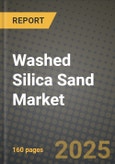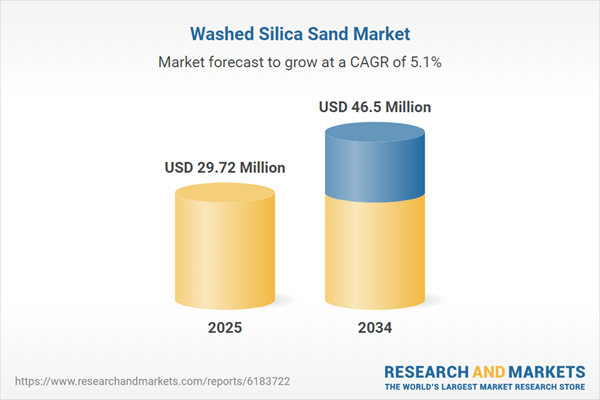Washed Silica Sand Market
Washed silica sand is a high-spec industrial mineral refined through wet processing (screening, attrition, classification, magnetic separation, dewatering) to deliver controlled particle size, low silt/clay, and reduced iron and heavy mineral content. It underpins a wide range of applications where purity and consistency are critical: flat/solar/container glass, foundry molds and cores, construction chemicals and dry-mix mortars, filtration media for municipal/industrial water, fiberglass and ceramics, paints and coatings fillers, sports turf and landscaping, and oil & gas proppants in select basins. Current development emphasizes low-iron grades for photovoltaic glass, tighter PSD windows for filtration and foundry, and stable whiteness/brightness for premium architectural finishes. Demand is supported by urbanization, water infrastructure upgrades, rising solar deployments, packaging glass resilience, and steady RMI activity in construction. On the supply side, producers are investing in modular wet-processing plants with closed-loop water circuits, tailings management, and online QA (laser diffraction, colorimetry) to meet procurement scorecards on quality and sustainability. Competitive dynamics feature integrated miners and regional processors securing reserves near end-markets, alongside long-term offtake with glassmakers and EPCs. Key challenges include permitting and water use, environmental and occupational-health compliance for crystalline silica, freight and port capacity, and exposure to energy-intensive processing steps. Although cullet usage in glass can temper virgin sand needs, fast-growing solar glass, water treatment, and high-spec construction mixes sustain structurally healthy demand for washed, low-contaminant silica.Washed Silica Sand Market Key Insights
- Quality is the currency. Low Fe₂O₃, tight PSD, low turbidity, and controlled heavy minerals decide vendor lists for solar/flat glass, foundry, and filtration; consistent laboratory and in-line analytics are now table stakes.
- PV glass reshapes specs. Rapid solar build-out lifts demand for low-iron, low-contaminant grades and favors plants with magnetic/optical separation and fine classification to hit optical clarity and seed-bubble targets.
- Water treatment broadens the base. Municipal and industrial filtration projects require calibrated grain distributions and angularity; pre-washed, pre-graded media reduce on-site commissioning time and warranty risk.
- Foundry sands move up the value curve. Stable GFN, roundedness, and low LOI enable thinner wall castings and higher yields; reclamation and thermal reconditioning complement fresh washed feed in mature foundry clusters.
- Construction chemicals prize consistency. Dry-mix mortars, flooring, grouts, and textured coatings rely on low-moisture, dust-controlled washed sands to deliver pumpability, finish quality, and color fidelity across seasons.
- Technology is the differentiator. Attrition cells, high-gradient magnets, hydrocyclone/hydrosizer circuits, and smart water recovery (thickeners, presses) lower impurities and operating cost while tightening ESG metrics.
- Logistics drive delivered cost. Proximity to glass/foundry corridors, access to rail/port spurs, and moisture-managed stockpiles often outweigh raw ore quality in total landed economics.
- Compliance is non-negotiable. Tighter rules on respirable crystalline silica, tailings, and water abstraction push producers toward enclosure, dust suppression, and closed-loop circuits - now key selection criteria for global buyers.
- Cullet and substitution are nuanced. Higher recycled glass content can trim virgin needs in container lines, yet solar/architectural glass still requires high-purity silica; specialty grades retain pricing power.
- Portfolio resilience matters. Suppliers balancing glass, filtration, construction, and foundry exposure mitigate cyclicality from proppant or construction downturns, supporting steadier utilization and cash flow.
Washed Silica Sand Market Reginal Analysis
North America
Demand is anchored by glass (packaging, architectural, and expanding solar) and resilient municipal/industrial filtration upgrades. Foundry clusters in the Midwest favor tight GFN and low-impurity supply, with reclamation tempering fresh intake. Proppant demand remains basin-specific and cyclical, rewarding producers closest to in-basin terminals. Environmental compliance and community permitting steer investments toward enclosed processing, dry tailings, and advanced dust control. Rail connectivity and moisture-managed stockpiles are decisive in delivered-cost competitiveness.Europe
Stringent environmental norms and high energy costs prioritize efficient wet-processing and water recirculation. Mature container and flat glass markets emphasize low-iron grades and stable particle shape; cullet integration is high but does not displace specialty solar and architectural needs. Foundry demand concentrates in automotive and machinery belts with strong QA requirements. Import reliance persists for select high-purity niches, while inland logistics and cross-border harmonization shape procurement. Traceability, LCA documentation, and chain-of-custody audits are standard in tenders.Asia-Pacific
APAC leads in glass capacity and solar glass expansion, driving significant consumption of low-iron washed silica. Fast-growing construction and dry-mix markets in India and Southeast Asia value consistent PSD and brightness, while Japan/Korea emphasize ultra-clean grades for electronics-adjacent applications. Export hubs supply high-purity sand to regional float/solar lines, though shifting export policies encourage domestic beneficiation. Water-efficient processing and coastal logistics reduce unit costs and support large-lot contracts.Middle East & Africa
Infrastructure, hospitality, and desalination/water projects sustain steady demand for washed filtration and construction sands. New and upgraded float glass lines in the Gulf require low-iron supply with reliable long-term offtake. Import-reliant North and Sub-Saharan markets emphasize port access, bulk handling, and moisture control under hot climates. Regulatory focus on water abstraction and dust emissions drives preference for plants with closed-loop circuits and robust environmental stewardship.South & Central America
Urban housing, packaging glass, and beverage sectors support baseline offtake, complemented by municipal water programs. Brazil and select Andean markets host foundry and container clusters that prioritize stable PSD and low impurities. Currency and freight volatility push for proximity sourcing and on-site stockpile management to maintain specification and lead times. Producers invest in modular wet-processing, magnetic upgrades, and reclamation partnerships to meet quality targets while managing operating costs.Washed Silica Sand Market Segmentation
By Application
- Glass manufacturing
- Foundry
- Construction
- Ceramics and refractories
- Others
By Method
- Wet washing
- Dry washing
- Attrition scrubbing
- Acid leaching
Key Market players
Sibelco, U.S. Silica, Covia, Badger Mining Corporation, Hi-Crush, Pattison Sand, VRX Silica, Allup Silica, Quarzwerke Group, Tochu Corporation, Euroquarz, Cairo Fresh, Ashapura Group, PUM Group, Australian Silica Quartz GroupWashed Silica Sand Market Analytics
The report employs rigorous tools, including Porter’s Five Forces, value chain mapping, and scenario-based modelling, to assess supply-demand dynamics. Cross-sector influences from parent, derived, and substitute markets are evaluated to identify risks and opportunities. Trade and pricing analytics provide an up-to-date view of international flows, including leading exporters, importers, and regional price trends.Macroeconomic indicators, policy frameworks such as carbon pricing and energy security strategies, and evolving consumer behaviour are considered in forecasting scenarios. Recent deal flows, partnerships, and technology innovations are incorporated to assess their impact on future market performance.
Washed Silica Sand Market Competitive Intelligence
The competitive landscape is mapped through proprietary frameworks, profiling leading companies with details on business models, product portfolios, financial performance, and strategic initiatives. Key developments such as mergers & acquisitions, technology collaborations, investment inflows, and regional expansions are analyzed for their competitive impact. The report also identifies emerging players and innovative startups contributing to market disruption.Regional insights highlight the most promising investment destinations, regulatory landscapes, and evolving partnerships across energy and industrial corridors.
Countries Covered
- North America - Washed Silica Sand market data and outlook to 2034
- United States
- Canada
- Mexico
- Europe - Washed Silica Sand market data and outlook to 2034
- Germany
- United Kingdom
- France
- Italy
- Spain
- BeNeLux
- Russia
- Sweden
- Asia-Pacific - Washed Silica Sand market data and outlook to 2034
- China
- Japan
- India
- South Korea
- Australia
- Indonesia
- Malaysia
- Vietnam
- Middle East and Africa - Washed Silica Sand market data and outlook to 2034
- Saudi Arabia
- South Africa
- Iran
- UAE
- Egypt
- South and Central America - Washed Silica Sand market data and outlook to 2034
- Brazil
- Argentina
- Chile
- Peru
Research Methodology
This study combines primary inputs from industry experts across the Washed Silica Sand value chain with secondary data from associations, government publications, trade databases, and company disclosures. Proprietary modeling techniques, including data triangulation, statistical correlation, and scenario planning, are applied to deliver reliable market sizing and forecasting.Key Questions Addressed
- What is the current and forecast market size of the Washed Silica Sand industry at global, regional, and country levels?
- Which types, applications, and technologies present the highest growth potential?
- How are supply chains adapting to geopolitical and economic shocks?
- What role do policy frameworks, trade flows, and sustainability targets play in shaping demand?
- Who are the leading players, and how are their strategies evolving in the face of global uncertainty?
- Which regional “hotspots” and customer segments will outpace the market, and what go-to-market and partnership models best support entry and expansion?
- Where are the most investable opportunities - across technology roadmaps, sustainability-linked innovation, and M&A - and what is the best segment to invest over the next 3-5 years?
Your Key Takeaways from the Washed Silica Sand Market Report
- Global Washed Silica Sand market size and growth projections (CAGR), 2024-2034
- Impact of Russia-Ukraine, Israel-Palestine, and Hamas conflicts on Washed Silica Sand trade, costs, and supply chains
- Washed Silica Sand market size, share, and outlook across 5 regions and 27 countries, 2023-2034
- Washed Silica Sand market size, CAGR, and market share of key products, applications, and end-user verticals, 2023-2034
- Short- and long-term Washed Silica Sand market trends, drivers, restraints, and opportunities
- Porter’s Five Forces analysis, technological developments, and Washed Silica Sand supply chain analysis
- Washed Silica Sand trade analysis, Washed Silica Sand market price analysis, and Washed Silica Sand supply/demand dynamics
- Profiles of 5 leading companies - overview, key strategies, financials, and products
- Latest Washed Silica Sand market news and developments
Additional Support
With the purchase of this report, you will receive:- An updated PDF report and an MS Excel data workbook containing all market tables and figures for easy analysis.
- 7-day post-sale analyst support for clarifications and in-scope supplementary data, ensuring the deliverable aligns precisely with your requirements.
- Complimentary report update to incorporate the latest available data and the impact of recent market developments.
This product will be delivered within 1-3 business days.
Table of Contents
Companies Mentioned
- Sibelco
- U.S. Silica
- Covia
- Badger Mining Corporation
- Hi-Crush
- Pattison Sand
- VRX Silica
- Allup Silica
- Quarzwerke Group
- Tochu Corporation
- Euroquarz
- Cairo Fresh
- Ashapura Group
- PUM Group
- Australian Silica Quartz Group
Table Information
| Report Attribute | Details |
|---|---|
| No. of Pages | 160 |
| Published | November 2025 |
| Forecast Period | 2025 - 2034 |
| Estimated Market Value ( USD | $ 29.72 Million |
| Forecasted Market Value ( USD | $ 46.5 Million |
| Compound Annual Growth Rate | 5.1% |
| Regions Covered | Global |
| No. of Companies Mentioned | 15 |









